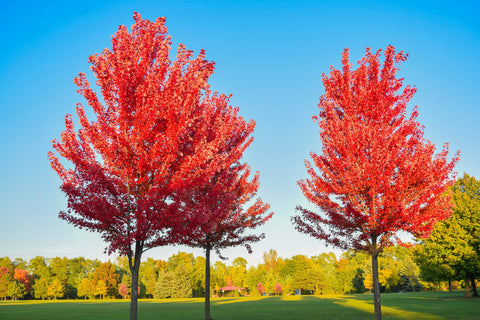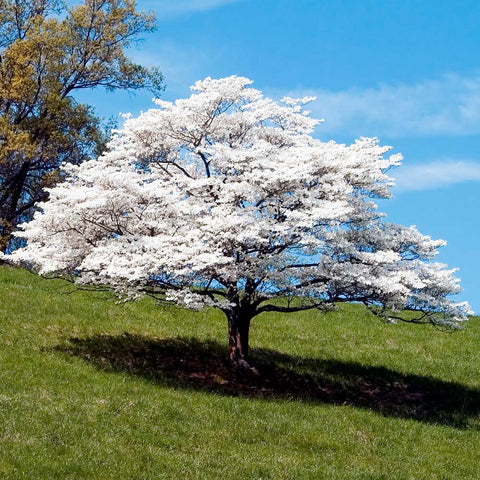As summer slowly gives way to autumn and the days start to shorten, the landscape slowly begins to light up with an explosion of brilliant color. Fall is nature’s last hurrah before winter sets in, and few things in the natural world compare to the sight of fall foliage. While many tree species put on a remarkable show as their leaves transition from greens to yellows and reds, a couple of the most magnificent are the red maple and the sourwood. Each provides an unrivaled pop of color that can make even the most unremarkable yards and woodlands explode with scarlet, crimson, and flaming orange. Leaves on both species seem to almost glow with reflected sunlight in the low autumn rays, drawing in visitors by the thousands to forests, city parks, and nature reserves across the country.

As its common name implies, the red maple is one of the most vibrant and recognizable symbols of fall in North America. Its leaves show the perfect color for the season, shifting from green during summer to red and orange as the temperatures drop. Each tree slowly fades in its own way, creating a diverse and swirling mix of colors that depends on the local weather, soil conditions, and sunlight exposure. The result is a blanket of brilliant reds, oranges, and sometimes yellows, lifting the mood of anyone who sees it.
One of the reasons the red maple is such a popular tree is that it is very easy to grow, being well-adapted to a wide range of soil conditions, climates, and landscapes. They will do well in wet lowlands or on dry upland ridges and can be found east of the Mississippi in nearly every region of the country. A single specimen will often grow for years on a roadside, in the woods, or in someone’s backyard, waiting for autumn to arrive. Their leaves have three distinct lobes and a fine texture, and like most maples, they seem to absorb the light around them in the fall, shining from within like incandescent bulbs. Even a single red maple in the yard is enough to light up an entire property with a fiery crown of leaves.
In addition to its dazzling fall color, the red maple is a very nice shade tree all year round. As a spring ephemeral, it puts out a modest display of small red flowers before its leaves emerge. The effect is understated but adds a little color to an otherwise bland landscape long before most other trees even begin to bud. Their growth rate is fast, but they mature into a graceful, symmetrical tree. These qualities make red maples a favorite among many homeowners and landscapers, as they fill the landscape with dramatic fall color without taking up too much space or getting out of control.
Animals love the red maple as well, with songbirds nesting in its branches and squirrels happily feasting on the winged seeds that cascade to the ground in large numbers each fall. The tree’s versatility, resilience, and low maintenance requirements make it an excellent choice for anyone looking to brighten up their landscape with spectacular fall color.
The sourwood tree is a little less showy than the red maple, but its beauty deepens the longer the fall season progresses. It is a small to medium-sized deciduous hardwood tree that grows in the southeastern United States. As its common name suggests, the sourwood tree puts on an amazing display of fall foliage. Its leaves turn from their bright summer green to a scarlet so deep and rich, it is often more purple than red. The colors may range from brilliant scarlet to deep maroon or burgundy, and provide a stunning contrast to nearby trees showing yellow or gold foliage. Sowers also hold their leaves late into the season, so their color often lingers long after most other trees have turned bare.
In addition to its great fall color, the sourwood is a tree with an attractive and graceful shape. The crown of the tree forms with a gentle, cascading curve, while the bark becomes thick, ridged, and furrowed as it matures. Sourwoods tend to stay relatively small compared to other hardwoods and, in summer, they produce lovely small, white flowers that dangle in pendent clusters resembling miniature lily-of-the-valley blooms. These blossoms are highly fragrant and a favorite of honeybees. Sourwood honey is light in color and has a distinctive taste that makes it highly prized. Because of this, some people appreciate sourwood trees even more knowing their special relationship with the honeybee.
Sourwoods grow best in well-drained, acidic soils and prefer full sun to partial shade. You will often find them on wooded slopes or at the edge of a forest that has enough sunlight to bring out the best color. Because they tend to stay relatively small, compared to other hardwoods, sourwoods make an excellent choice for many gardens, patios, or small landscapes where a red maple might get too big. Their growth is a bit slower than the red maple, but if you are patient you will be rewarded with year after year of consistent beauty.
If you plant a sourwood and red maple together in the same landscape they will create an amazing combination of fall colors. The bold, fire-like tones of the red maple pair beautifully with the deeper, burgundy and wine shades of the sourwood. On a clear, blue fall day the two can seem to set the horizon on fire with their color. The shades also complement the fall season itself, being both warm and welcoming even as the year winds down.
The science behind the vibrant colors is as interesting as the view itself. As the days shorten and cool temperatures arrive, the chlorophyll in the leaves begins to slow and finally stops. The green pigment that hides the natural reds, oranges, and yellows fades, and those colors begin to show. In red maples, high concentrations of sugar trapped in the leaves can enhance the red and crimson pigments. The same thing is true of sourwoods, which bring out darker, wine-colored tones. The intensity of the color change depends on the weather, with cool nights and sunny days tending to make the colors more vibrant. Hot or rainy weather can mute the colors, so autumn may be less brilliant in some years than others.
Planting red maple and sourwood trees is an investment in beauty for any homeowner or gardener, as they both bring back such a high reward for very little work. Both trees are relatively low maintenance once they are established and require nothing more than good, healthy soil and an appreciation for the seasonality of their native range. The reward comes each fall when these trees become centerpieces of the landscape, putting on a display of color so vibrant it almost seems to emanate from within the leaves themselves.
Whether in a suburban yard, along a country driveway, or in a city park, these trees are a joy to behold and draw people into the season. They also remind us to stop and appreciate the fleeting beauty of the changing world around us. Few things compare to a crisp fall morning when the air is still cool and the first frost glitters on the ground, when the fields are full of color and these two trees provide proof that nature’s creativity never ends, it only changes color.






